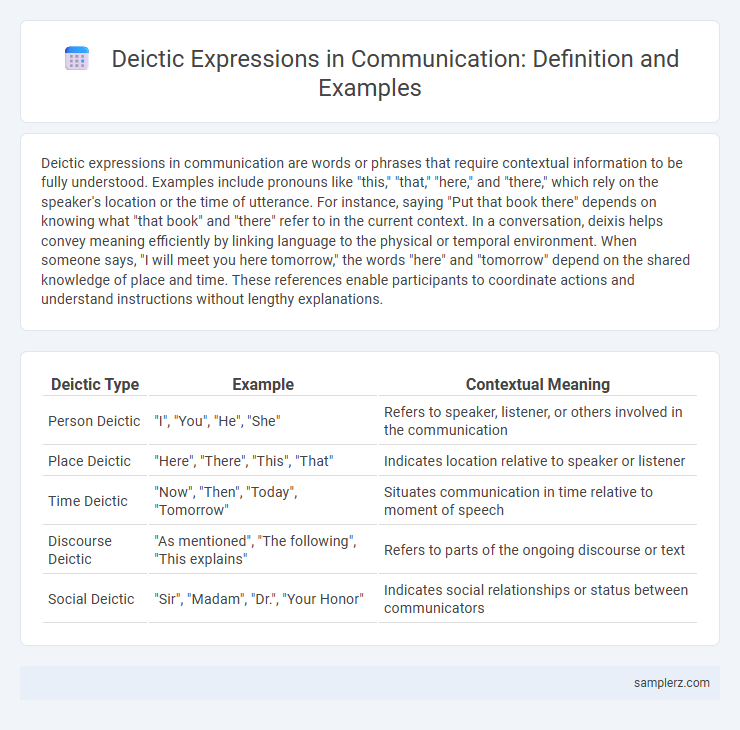Deictic expressions in communication are words or phrases that require contextual information to be fully understood. Examples include pronouns like "this," "that," "here," and "there," which rely on the speaker's location or the time of utterance. For instance, saying "Put that book there" depends on knowing what "that book" and "there" refer to in the current context. In a conversation, deixis helps convey meaning efficiently by linking language to the physical or temporal environment. When someone says, "I will meet you here tomorrow," the words "here" and "tomorrow" depend on the shared knowledge of place and time. These references enable participants to coordinate actions and understand instructions without lengthy explanations.
Table of Comparison
| Deictic Type | Example | Contextual Meaning |
|---|---|---|
| Person Deictic | "I", "You", "He", "She" | Refers to speaker, listener, or others involved in the communication |
| Place Deictic | "Here", "There", "This", "That" | Indicates location relative to speaker or listener |
| Time Deictic | "Now", "Then", "Today", "Tomorrow" | Situates communication in time relative to moment of speech |
| Discourse Deictic | "As mentioned", "The following", "This explains" | Refers to parts of the ongoing discourse or text |
| Social Deictic | "Sir", "Madam", "Dr.", "Your Honor" | Indicates social relationships or status between communicators |
Understanding Deictic Expressions in Communication
Deictic expressions such as "here," "there," "this," and "that" play a crucial role in communication by anchoring meaning to the speaker's context. Understanding deictic terms requires recognizing the spatial, temporal, and personal perspectives they reference, which helps receivers interpret messages accurately within a shared environment. Effective communication depends on accurately decoding these expressions to avoid misunderstandings in dialogue.
Types of Deictic References: Person, Place, and Time
Deictic references in communication clarify meaning by indicating person, place, or time relative to the speaker and listener. Person deixis uses pronouns like "I," "you," and "they" to specify participants in the conversation. Place deixis involves spatial terms such as "here," "there," and "this," while time deixis refers to temporal expressions like "now," "then," and "yesterday" to anchor the event in time.
Deictic Pronouns: “I”, “You”, and “We” in Conversation
Deictic pronouns such as "I," "You," and "We" play a crucial role in communication by directly referencing participants within a conversation, establishing relational context and speaker identity. The pronoun "I" identifies the speaker's perspective, "You" addresses the listener, and "We" includes both parties, facilitating mutual understanding and engagement. These pronouns dynamically shift meaning based on the conversational context, enabling precise and efficient interpersonal interaction.
Spatial Deixis: Locational Terms in Everyday Speech
Spatial deixis in communication involves locational terms such as "here," "there," "this," and "that," which rely on the speaker's and listener's physical context to convey meaning. For example, saying "Put the book over there" requires both parties to understand the relative position indicated by "there" to accurately interpret the message. These deictic expressions anchor utterances to specific spatial points, enhancing clarity in everyday interactions.
Temporal Deixis: Talking About Time in Communication
Temporal deixis in communication involves referencing time points relative to the moment of speaking, such as "now," "then," or "tomorrow." For example, saying "I'll finish the report tomorrow" anchors the action to a specific future time from the speaker's perspective. This usage helps listeners understand when events occur in relation to the present, making temporal deixis crucial for clear and effective communication.
Deictic Demonstratives: Using “This”, “That”, “These”, “Those”
Deictic demonstratives like "this," "that," "these," and "those" function as crucial linguistic markers that help speakers anchor their messages in the immediate physical or discourse context. For example, in a conversation about documents, saying "This report highlights the key findings" directs attention to a specific, proximal item, while "Those statistics seem outdated" refers to something more distant or previously mentioned. These terms enable efficient, context-dependent communication by minimizing ambiguity and reinforcing shared understanding between interlocutors.
Deictic Verbs: Illustrating Motion and Perspective
Deictic verbs such as "come," "go," and "bring" illustrate motion relative to the speaker's location, anchoring communication in spatial context. For example, "I will come to your office" indicates movement toward the listener's position, while "She goes to the market" situates the action from the speaker's viewpoint. These verbs dynamically convey perspective and orientation, making them essential for effective spatial and contextual referencing in communication.
Deictic Expressions in Digital Communication
Deictic expressions such as "here," "there," "this," and "that" play a crucial role in digital communication by anchoring messages to specific contexts or locations within a virtual environment. In instant messaging and social media platforms, users frequently employ deictic terms to indicate shared understanding or direct attention to particular content, like referencing "this post" or "that comment." The effective use of these expressions enhances clarity and engagement by situating information relative to the speaker's or recipient's position in digital discourse.
Cultural Variations in Deictic Usage
Deictic expressions such as "here," "there," and "you" vary significantly across cultures, reflecting differing spatial, temporal, and social frameworks. For example, Japanese uses honorific forms and context-specific deixis that emphasize social hierarchy, while in Spanish, gestures often accompany verbal deixis to clarify meaning. Understanding these cultural variations in deictic usage is crucial for effective cross-cultural communication and minimizing misunderstandings.
Challenges and Misunderstandings with Deictic Communication
Deictic communication often leads to challenges and misunderstandings due to its reliance on context-dependent references like "this," "that," or "here" without explicit clarification. In cross-cultural or remote communication, deictic expressions can cause confusion because the shared physical or situational context is absent or interpreted differently. Misinterpretations of deictic terms frequently result in unclear instructions, ambiguous messages, and communication breakdowns in professional and personal interactions.

example of diectic in communication Infographic
 samplerz.com
samplerz.com